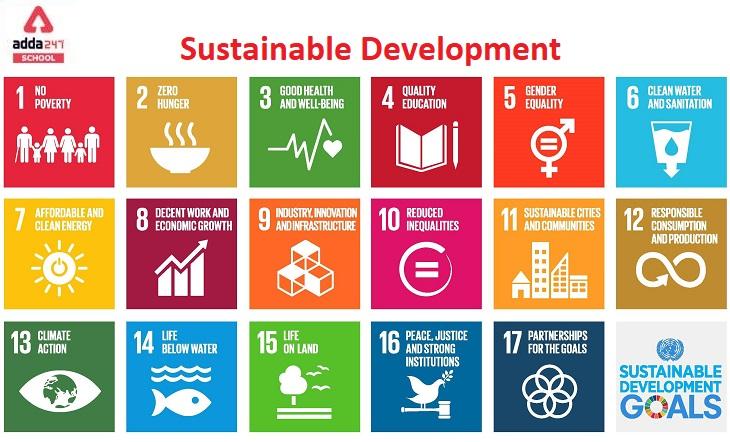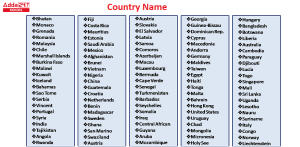The CBSE Syllabus of class 10 includes Sustainable Development Projects to develop and increase general awareness in students. Class 10th candidates need to create and submit Class 10 Social Science projects on Sustainable Development. In this article, you can find some innovative project ideas, graphics to use, well-designed acknowledgement pages, and even whole project files. Our team has also shared different inspiring project ideas for school students. Check them out at the Adda247 School website.
Sustainable Development Project
The term “sustainable development” is probably familiar to you from those dull Social Studies classes. If you’re wondering what it is, you’ve come to the perfect place. Sustainable development is defined as development that meets present demands while ensuring that future generations can meet their own. One of the most popular project ideas in Class 10 is on sustainable development. In this post, we defined sustainable development, discussed its goals, and provided examples to assist students in developing effective Class 10 sustainable development projects.
What is Sustainable Development?
Sustainable development is a concept and method that aims to balance economic growth, social progress, and environmental protection in a way that serves the demands of the current generation without jeopardizing future generations’ ability to satisfy their own needs. Creating a more sustainable and resilient future entails merging economic development, social fairness, and environmental stewardship.
The United Nations World Commission on Environment and Development published the Brundtland Report, popularly known as “Our Common Future,” in 1987, which popularized the concept of sustainable development. According to the report, sustainable development is “development that meets the needs of the present without compromising future generations’ ability to meet their own needs.”
Sustainable Development Principle
The principles of sustainable development are :
1. Environmental protection entails conserving and responsibly managing natural resources, protecting ecosystems, and reducing the negative environmental impact of human activities.
2. Social equity is concerned with ensuring that development benefits all members of society, promotes social inclusion, decreases inequities, and upholds human rights.
3. Economic Development: Sustainable development emphasizes long-term inclusive economic growth, job creation, and innovation, while simultaneously considering resource efficiency and minimizing negative environmental repercussions.
4. Intergenerational Equity: It emphasizes the current generation’s responsibility to consider the needs and well-being of future generations.
Sustainable Development Class 10 Project
So, in real-world terms, sustainable development is about meeting our needs today without making it harder for future generations to meet their needs. It’s like balancing a three-legged stool of environment, economy, and society. If one leg is too short or too long, the stool will tip over.
Sustainable Development Project Class 10 Examples
- Recycling: Instead of throwing away plastic bottles, we recycle them so they can be turned into new products. This way, we don’t have to keep making new plastic, which is hard on the environment.
- Solar Power: Using solar panels to generate electricity is sustainable because the sun isn’t going away anytime soon (fingers crossed!). Unlike coal, which can run out and also pollutes the air, solar power is clean and renewable.
- Public Transport: When we use buses or trains instead of everyone driving their own car, it’s better for the environment. Fewer cars mean less pollution and less traffic, making the air cleaner for everyone.
- Local Food: Buying food that’s grown nearby isn’t just good for your taste buds; it’s also good for the planet. It doesn’t have to travel as far to get to you, which means less fuel is used, and that’s a win for the environment.
- Reusable Items: Using a reusable water bottle or shopping bag means you’re not constantly throwing things away. This reduces waste and helps keep our planet cleaner.
Sustainable Development Project for Students
The ability of future generations to meet their own needs is not compromised when current demands are met through sustainable development. The assertion is accurate and offers a goal many people want, but it makes no recommendations or guarantees about gauging progress toward sustainable development. Sustainability is frequently used interchangeably with “sustainable development.” Expansion can be thought of as development. Thus sustainable development involves addressing the issue brought on by ongoing economic growth without posing a threat.
Following the publication of the acclaimed report “Our Common Future” by the World Commission on Environment and Development in 1987, the phrase “sustainable development” became widely used in the international scientific community. To learn more about sustainable development, read the article below.
Project on Sustainable Development Characteristics
The following cases indicate the fundamental traits of sustainable development:
- Real per capita income and economic welfare should continue to increase over the long run.
- Simply said, sustainable development means that resources should be utilized organically and without overusing them.
- Sustainable development aims to use natural resources and the environment to raise the standard of living while preserving future generations’ capacity to meet their own needs.
- Promoting environmentally friendly and biodegradable products is a goal of sustainable development, as is establishing sustainable plans for resource replacement or replenishment.
- Green architecture and other environmentally friendly building techniques are emphasized in sustainable development.
Sustainable Development Project Scopes
The interplay between a business’s legal interests and the economy, the government and politics, civil society, and culture is seen as the essence of sustainable development. These social interactions do not, however, occur in isolation. The carrying capacity of various ecosystems, landscape ecology, and ultimately the Earth’s biosphere or Nature bind society on a physical and material level. The caring ability of a person examines the threefold functional division of society on the spiritual and psychological levels. Therefore, we can claim that sustainable development is a multidimensional notion with at least four dimensions.
Sustainable Development Projects – Defending Against The Environmental Crisis
The endeavor made by sustainable development to combat the environmental catastrophe, which might be linked to unchecked economic expansion, is what gives it its importance. An environmental crisis occurs when nature cannot maintain living forms or carry out fundamental tasks necessary for the survival of life.
The definition of sustainable development aims to limit resource extraction so that it doesn’t outpace rates of resource generation. Furthermore, it strives to regulate waste generation to guarantee that it remains below the natural absorption capacities of the ecosystem.
Sustainable Development Project Principles/ Premises
The concept of sustainable development is based on the following ideas or premises:
- The alternative approach to development, known as sustainable development, is by definition resource- and eco-friendly.
- Sustainable development has two main facets: internal sustainability and external sustainability. Both would prevent the emergence of truly sustainable development.
- Long-term sustainable development requires preserving relationships with the environment, resources, and people, as well as their service providers, institutions, and other components of their social networks.
- Economic progress that depletes natural resources is rarely effective.
- Since sustainable development is mostly to blame for the poor, it should make sure that they have appropriate access to a safe and sustainable way of life.
- Because past patterns of environmental degradation are inevitable, the environmental follies of the past shouldn’t be repeated.
- Development and the environment may coexist together. Economic progress depends on both a healthy economy and the environment.
- The natural systems of the consumer and producer are interdependent.
- In order to ensure that productive assets accessible to future generations are not unfairly diminished, the current generation must meet its demands without impairing its ability to meet its own requirements.
- By unnecessarily destroying the Earth’s finite resources and polluting its ecosystem and environment, those who benefit from economic progress must care not to worsen the resources of future generations.
- Instead of concentrating solely on growth, development should aim for more general objectives of social transformation.
Sustainable Development Projects for Class 10 Core Elements
The following are the core elements of Sustainable Development.
1. Environmental conservation: The main goal of sustainable development is to preserve the environment in order to prevent the depletion of the resources it provides.
2.Social development: It attempts to improve an individual’s and society’s overall well-being. It involves ensuring that individuals have access to the resources they need, adequate healthcare, and a good standard of living.
3.Economic Progress: By convincing them of its long-term benefits and promoting both the environmental and social aspects of the cause, it persuades individuals to invest in sustainable endeavors.
Sustainable Development Projects Examples
Here are several examples of sustainable development, some of which have little impact on the environment and prove to be cost-effective over time.
- Turbines that utilize hydro energy.
- Windmills frequently use wind energy.
- With advances in solar cells and related technologies, solar energy is being used more widely.
- Effective and recycled water utilization.
- Sustainable building techniques and green architecture.
- Crop rotation and other related farming practises.
- Upkeep and expansion of environmentally friendly green places.
Sustainable Development Project Goals
The following are the top three aims of sustainable development:
- To develop new areas while using the fewest natural resources possible.
- To build a sustainable environment that won’t harm the environment in any way.
- To offer a technique for reconstructing current developments so that they have eco-friendly initiatives and facilities.
International organizations such as NGOs, United Nations, aid organizations, and even governments are making continuous sponsoring efforts to ensure that the goal of sustainable development is achieved for every individual across the globe. Some other goals of sustainable development set by these bodies are:
- Elimination of poverty across the world
- Ensure good health and well being
- Provision for clear water and sanitation
- Provision of quality education for all
- Achieving Gender Equality
- Allowing access to economical and clean energy
- Building up strong infrastructure, Supporting Inclusive and Sustainable Industrialization and encouraging innovation
17 Sustainable Development Project Goals for Class 10
Global concerns are addressed by sustainability goals, such as the current UN Sustainable Development Goals. Poverty, inequality, climate change, environmental degradation, peace, and justice are among the global concerns. The Brundtland Report of 1987 is largely responsible for the present notion of sustainable development. However, as the notion of sustainable development has evolved, it has shifted its focus to include economic, social, and environmental development for future generations.
The Sustainable Development Goals (SDGs) are a series of 17 interconnected global goals established by the United Nations General Assembly (UN-GA) in 2015 and targeted to be realised by 2030. These 17 interconnected global goals, known as the Sustainable Development Goals, are contained in an UN-GA Resolution known as the 2030 Agenda, or Agenda 2030.
The Sustainable Development Goals include:
- No Poverty
- Zero Hunger
- Good Health and Well-Being
- Quality Education
- Gender Equality
- Clean Water and Sanitation
- Affordable and Clean Energy
- Decent Work and Economic Growth
- Industry, Innovation, and Infrastructure are the 17 Sustainable Development Goals
- Inequality Reduction
- Sustainable Cities and Communities
- Responsible Consumption and Production
- Partnerships for the Goals
- Climate Action
- Life Below Water
- Life On Land
- Peace, Justice, and Strong Institutions
Sustainable Development Project PDF for Class 10
The sustainable development project pdf for class 10 is given below.
Click Here to Download the Sustainable Development Project PDF
Sustainable Development Project Goals How are they monitored?
A range of technologies exists to track and illustrate progress toward the goals to aid monitoring, with the purpose of making data more accessible and understandable. For example, the online publication SDG Tracker, which was published in June 2018, shows accessible data across all indicators, and then the SDGs addressed many cross-cutting concerns such as gender equity, education, and culture, which cut across all of the SDGs. Furthermore, the COVID-19 pandemic had major consequences and implications for all 17 SDGs in 2020.
Project on Sustainable Development Ideas
Check out some Sustainable Project Examples given below
Environmental Projects
The natural environment is concerned with environmental sustainability. It is concerned with how the natural environment can stay diversified and productive, as natural resources are derived from it. The state of the air, water, and climate are of particular significance. Environmental sustainability comprises using water responsibly, employing renewable energy, and using sustainable material supplies while meeting human requirements while conserving the planet’s life support systems.
When natural resources are depleted faster than they can be replenished, an unsustainable scenario arises, which is why human activity must only consume natural resources at the rate at which they can be replenished organically. The inability to sustain human life is a long-term effect of environmental degradation, and such deterioration on a global scale should suggest an increase in human death rates until the population falls below what the deteriorated ecosystem can support.
Economical Projects
Environmental resources should be recognised as essential economic assets, according to some, because of rural poverty and overexploitation. Growth in the gross domestic product is required for economic progress. Many people’s quality of life may increase as a result of sustainable development, but it may also necessitate a reduction in resource usage. Environmental conservation and economic growth goals, according to The Concept of Sustainable Economic Development, are not mutually exclusive and can even be mutually reinforcing.
According to a 1999 World Bank study, policymakers have a wide range of options for increasing sustainability based on the principle of true savings. Effective strategies for renewable energy and pollution have been found to be compatible with increased human welfare in several studies. Three pillars of sustainable development were discovered in the study, Interpreting Sustainability in Economic Terms. Interlinkage, intergenerational equity, and dynamic efficiency are the three pillars of sustainable development.
Political Projects
The United Nations Global Compact Cities Program has defined sustainable political development as the domain of practises and meanings associated with basic issues of social power as they pertain to the organisation, authorisation, legitimation, and regulation of a social life shared in common, broadening the usual definition beyond states and governance. This definition is consistent with the belief that political reform is necessary to address economic, ecological, and cultural concerns, and it also implies that the politics of economic change may be handled.
Cultural Projects
Some researchers and institutions have argued that a fourth dimension should be added to the dimensions of sustainable development, and the United Cities and Local Governments (UCLG) published the policy statement “Culture: Fourth Pillar of Sustainable Development” at the 2010 World Congress of UCLG, arguing for a new perspective and pointing to the relationship between culture and sustainable development. It emphasises the link between culture and long-term development by establishing a strong cultural policy and advocating for a cultural dimension in all government programmes.
Other organisations have endorsed the concept of the fourth domain of sustainable development as a critical component of a new sustainable development strategy.
Human-centred design and cultural collaboration have become prominent frameworks for sustainable development in marginalised groups, and these frameworks include open discourse, which includes sharing, arguing, and discussing, as well as a comprehensive assessment of the development site.
Sustainable Development Project in Class 10 Education
Education for Sustainable Development is abbreviated as ESD. Education for sustainable development is defined as education that promotes changes in knowledge, skills, values, and attitudes with the goal of empowering and equipping current and future generations to meet their needs through a balanced and integrated approach to sustainable development’s economic, social, and environmental dimensions. The phrase “education for sustainable development” is now commonly used worldwide.
Education must be emphasised in all agendas, programmes, and activities that promote sustainable development, as the concept of ESD was born out of a need for education to address the world’s growing and changing environmental concerns. According to the Education for Sustainable Development ideology, sustainable development must be integrated into education, and education must be integrated into sustainable development.
Sustainable Development Project in Training & Education
ESD encourages the inclusion of these critical sustainability issues in local and global contexts in the curriculum to better prepare students to understand and respond to the changing world and to produce learning outcomes that include critical and systematic thinking, collaborative decision-making, and taking responsibility for current and future generations. ESD necessitates not only a rethinking of the learning environment, both physical and virtual, but also a whole-institution approach to embedding the philosophy of sustainable development through it, because traditional single-directional knowledge delivery is insufficient to inspire learners to act as responsible citizens.
Project File on Sustainable Development
Creating a sustainable development project involves planning and implementing strategies that balance environmental, economic, and social considerations to meet current needs without compromising the ability of future generations to meet their own needs. Here’s a step-by-step guide to initiating a this type of project project:
- Define the Scope and Objectives:
- Identify the specific sustainability goals you want to achieve (e.g., reducing carbon emissions, improving community health, promoting education).
- Ensure these goals align with broader sustainability frameworks like the United Nations Sustainable Development Goals (SDGs).
- Stakeholder Engagement:
- Identify all relevant stakeholders (community members, businesses, local governments, NGOs).
- Engage with them to understand their needs, perspectives, and how they can contribute to the project.
- Conduct a Needs Assessment:
- Analyze the current situation to identify specific challenges and opportunities in the targeted area or community.
- Assess environmental, economic, and social factors.
- Develop a Sustainable Plan:
- Outline strategies and actions that address the identified needs and objectives.
- Ensure the plan incorporates sustainable practices, such as using renewable resources, minimizing waste, and promoting social equity.
- Resource Allocation:
- Determine the resources (financial, human, material) required for the project.
- Explore funding options like grants, sponsorships, or community fundraising.
- Implementation:
- Execute the project according to the plan.
- Ensure flexibility to adjust strategies in response to feedback or changing circumstances.
- Monitoring and Evaluation:
- Regularly monitor the project’s progress against its objectives.
- Collect data and feedback to evaluate the impact of the project.
- Adjust the plan as necessary based on the evaluation.
- Community Involvement and Education:
- Actively involve community members in the project.
- Educate them about sustainable practices and the project’s benefits to ensure long-term engagement and success.
- Sustainability and Scalability:
- Plan for the long-term sustainability of the project.
- Consider how the project can be scaled up or replicated in other areas.
- Reporting and Communication:
- Regularly communicate progress and results to stakeholders and the public.
- Share successes and challenges to promote learning and support for sustainable development.
Example Project: Community Solar Power Initiative
Objective: To reduce carbon emissions and energy costs in a local community.
Steps:
- Engage with local residents, businesses, and the municipality.
- Assess the community’s energy needs and solar potential.
- Plan a community solar farm where residents can buy or lease solar panels.
- Secure funding through local government grants, private investors, and community contributions.
- Install the solar farm with local labor.
- Monitor energy production and savings, and assess environmental impact.
- Provide educational workshops on renewable energy.
- Plan for maintenance and potential expansion of the solar farm.
- Regularly report to the community and stakeholders on the project’s impact.
- Document the process for other communities to replicate.
This project not only addresses environmental sustainability through renewable energy but also promotes economic savings and social equity by involving and benefiting the local community.









 Country Name in Alphabetical Order A to ...
Country Name in Alphabetical Order A to ...
 Eastern Ghats in India: Check Map, State...
Eastern Ghats in India: Check Map, State...
 No 1 School in India- Top 10 School List...
No 1 School in India- Top 10 School List...










